 Haunt Sweet Home by Sarah Pinsker
Haunt Sweet Home by Sarah Pinsker Format: eARC
Source: supplied by publisher via Edelweiss
Formats available: hardcover, ebook, audiobook
Genres: fantasy, horror, paranormal
Pages: 161
Published by Tordotcom on September 3, 2024
Purchasing Info: Author's Website, Publisher's Website, Amazon, Barnes & Noble, Kobo, Bookshop.org, Better World Books
Goodreads
On the set of a kitschy reality TV show, staged scares transform into unnerving reality in this spooky ghost story from multiple Hugo and Nebula Award-winning author Sarah Pinsker.
“Don’t talk to day about what we do at night.”
When aimless twenty-something Mara lands a job as the night-shift production assistant on her cousin’s ghost hunting/home makeover reality TV show Haunt Sweet Home, she quickly determines her new role will require a healthy attitude toward duplicity. But as she hides fog machines in the woods and improvises scares to spook new homeowners, a series of unnerving incidents on set and a creepy new coworker force Mara to confront whether the person she's truly been deceiving and hiding from all along—is herself.
Eerie and empathetic, Haunt Sweet Home is a multifaceted, supernatural exploration of finding your own way into adulthood, and into yourself.
My Review:
This wasn’t the book I planned to read this week, but after yesterday’s book I needed something with a bit harder of an edge, or a bit more adventure in its heart, or something other than cozy relationship fiction. I also needed something short because I flailed a bit.
I picked this out of the virtually towering TBR pile because I read the author’s “One Man’s Treasure” as part of my Hugo reading this year. I didn’t think it stuck the dismount but the story was a whole lot of fun as it went along.
And the premise of this one also looked like a whole lot of fun. I’m not sure whether it’s more fun or less fun if you believe, as I do, that “Reality TV” is an oxymoron, an inherent contradiction in terms. (And come to think of it, there’s another recent horror-adjacent story with a similar premise, The Holy Terrors by Simon R. Green – but Haunt Sweet Home is a much better, and more original, story.
Haunt Sweet Home lies at a surprising intersection of tropes and genres. OTOH, it’s a bit of an exposé of how the not-so-ghostly sausage of spooky reality TV shows get made. On a second hand, it’s about the grind of clinging by one’s fingernails to the lowest rung of the entertainment ladder – and discovering that the work is the thing one has been looking for all along.
And then there’s that third, ghostly hand, which really surprised me by circling back to Susan M. Boyer’s Liz Talbot series and thereby tying itself to yesterday’s book, as the protagonist, Mara, seems to have manifested or acquired or midwifed or all of the above, a sort of family ghost of her very own. By a method that owes more than a bit to Pygmalion – not the play or any of the adaptations of the play including the movies, but the original Greek myth about the man who sculpted his perfect woman and brought her to life.
Mara doesn’t sculpt a perfect paramour. Instead, she sculpts a perfect – or at least a more functional – version of her very own self. A version of herself that is a bit better at people, a bit less of an indecisive screw-up, much less of the family joke, and a whole lot better at believing in herself.
And very nearly decides to throw it all away. Because she’s started to believe entirely too many of her family’s so-called jokes than any one person can stand.
Escape Rating A-: I liked this a whole lot, and in fact a whole lot more than I expected to. Clearly, I don’t believe “Reality TV” has anything to do with actual reality, so reading a story that lampooned that genre at every turn was a good choice for me.
I also liked the horror-adjacency of this one, even though that’s why I had passed it by earlier in the month. I wasn’t sure how adjacent the horror was, but as it turns out the answer is – VERY. The TV series is simulating horror, manipulating or editing reactions to make it seem like horrors are happening – but everyone involved is very aware that it isn’t. Except for a bit of a tease at the end which just makes the whole damn thing work even better!
What really makes this story work is the character of Mara. She seems to be an afterthought for her whole family, the butt of every joke and the person voted least likely to succeed at every turn, to the point where she’s internalized all of that attitude.
It hurts her but she can’t make it stop. Every single thing she says or does goes through the family story editing machinery until it comes out that Mara is always lifeless, feckless and useless. She’s become entirely self-effacing because it no longer matters what she does – not even to herself.
At least not until her alter ego, her creation, her ghost avatar, Jo, comes into the picture. Because Jo IS Mara every bit as much as she is her own self. Jo sees Mara for who she really is on the inside – and isn’t in the least bit shy about telling Mara all about herself – no matter how much Jo KNOWS it’s gonna hurt. Because it needs to.
Someone needs to make Mara listen to the truths she doesn’t want to hear, and who better to make herself listen to those truths than herself? So Jo’s very existence, and Mara’s family’s reaction to a ‘better’ version of Mara forces Mara to confront those truths and do something about them. Which they do. Together. Even if it broke my librarian heart to watch them destroy most of a library to get there.
In spite of the terrible treatment of that poor library, it was still a terrific end to a really fun story.

 Time's Agent by
Time's Agent by  The Dead Cat Tail Assassins by
The Dead Cat Tail Assassins by 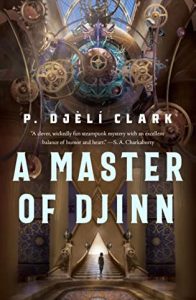 Escape Rating A+: I picked this up because I adored the author’s
Escape Rating A+: I picked this up because I adored the author’s  Navigational Entanglements by
Navigational Entanglements by  Escape Rating A-: I grabbed this book because I’ve been picking my way through the author’s vast, sprawling,
Escape Rating A-: I grabbed this book because I’ve been picking my way through the author’s vast, sprawling,  In the Shadow of the Fall (Guardians of the Gods, #1) by
In the Shadow of the Fall (Guardians of the Gods, #1) by  Something which I’m sure is intended to happen in the second book in the duology,
Something which I’m sure is intended to happen in the second book in the duology,  Unexploded Remnants by
Unexploded Remnants by  Service Model by
Service Model by 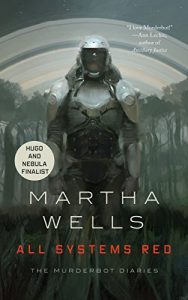 Escape Rating A+: I went into this completely unsure of what to expect, and that blurb of
Escape Rating A+: I went into this completely unsure of what to expect, and that blurb of  The Fireborne Blade (The Fireborne Blade, #1) by
The Fireborne Blade (The Fireborne Blade, #1) by  Escape Rating A-: Initially, this seemed like a rather traditional knight vs. dragon story, with one of two inevitable endings. Either the knight dies or the dragon does. Or occasionally both in a blaze of mutual glory. So there’s three inevitable endings.
Escape Rating A-: Initially, this seemed like a rather traditional knight vs. dragon story, with one of two inevitable endings. Either the knight dies or the dragon does. Or occasionally both in a blaze of mutual glory. So there’s three inevitable endings. And in the process of telling its story about the knight and the dragon, it asks some surprising questions about change vs stability and striking that balance, and makes that discussion personal in ways that change every single thing we thought we knew going in.
And in the process of telling its story about the knight and the dragon, it asks some surprising questions about change vs stability and striking that balance, and makes that discussion personal in ways that change every single thing we thought we knew going in. Lost Ark Dreaming by
Lost Ark Dreaming by 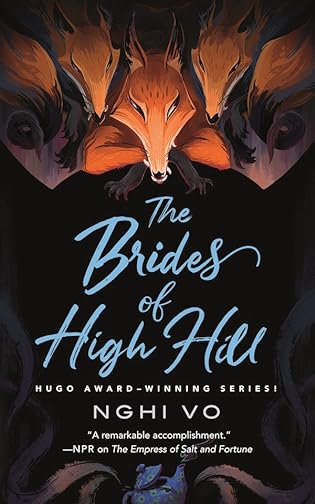 The Brides of High Hill (The Singing Hills Cycle, #5) by
The Brides of High Hill (The Singing Hills Cycle, #5) by 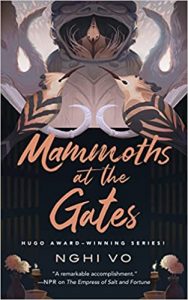 When we first catch up with Cleric Chih as they are accompanying bride-to-be Pham Nhung and her family on their trip to make the final negotiations for Pham Nhung’s marriage to the older and much wealthier Lord Guo, the reader has the sense that they remember when Chih met Nhung at the gates of the Singing Hills Abbey back in the previous book,
When we first catch up with Cleric Chih as they are accompanying bride-to-be Pham Nhung and her family on their trip to make the final negotiations for Pham Nhung’s marriage to the older and much wealthier Lord Guo, the reader has the sense that they remember when Chih met Nhung at the gates of the Singing Hills Abbey back in the previous book, 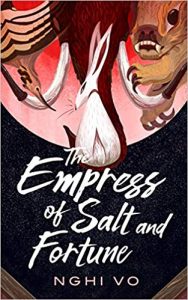 Escape Rating A-: From the very first book in the
Escape Rating A-: From the very first book in the 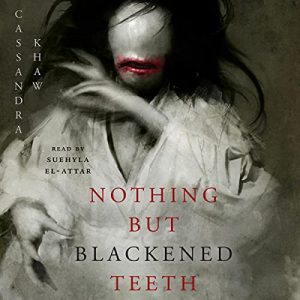 At the very beginning of The Brides of High Hill, Cleric Chih is remembering his late mentor, Cleric Thien, and an occasion where Thien told Chih that “Everything starts with a story,” and a very young and not yet cleric Chih asks, “But what does that mean?”
At the very beginning of The Brides of High Hill, Cleric Chih is remembering his late mentor, Cleric Thien, and an occasion where Thien told Chih that “Everything starts with a story,” and a very young and not yet cleric Chih asks, “But what does that mean?”